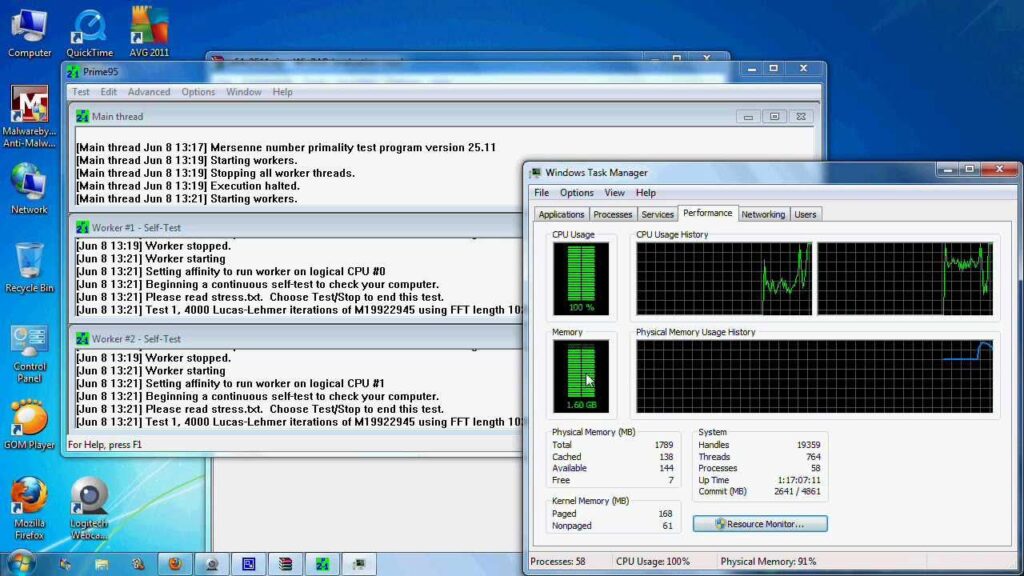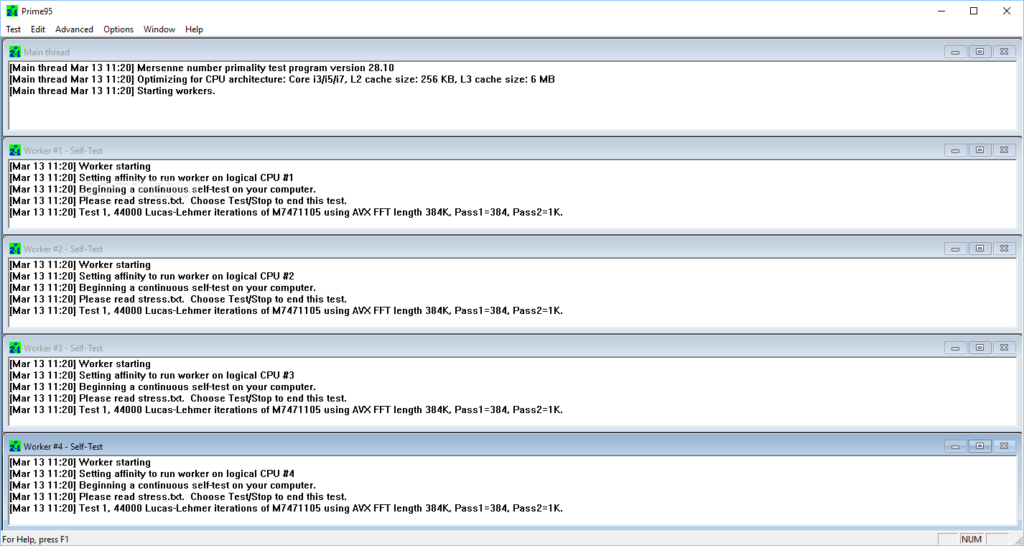Download Prime95 – a highly specialized software application primarily designed to stress-test computer systems, particularly focusing on the Central Processing Unit (CPU) and memory subsystems.
Prime95 operates by running a series of highly intensive mathematical computations on the CPU, effectively simulating a worst-case scenario for computational workloads. These computations are primarily based on the Lucas-Lehmer test, which is used to verify the primality of Mersenne numbers. The intensity of these calculations makes Prime95 an excellent tool for identifying weaknesses in system stability, such as inadequate cooling, insufficient power supply, or hardware defects.
About Prime95
Prime95’s development began in the mid-1990s as part of GIMPS, an initiative started by George Woltman to harness the computational power of personal computers worldwide in the search for large prime numbers. Initially, the software was intended solely for mathematicians and enthusiasts interested in number theory. However, the robustness of its algorithms, particularly the Lucas-Lehmer primality test, which is computationally intense, made it an ideal tool for stress testing.

Developed by George Woltman in 1996, Prime95 is part of the Great Internet Mersenne Prime Search (GIMPS) project, which aims to discover new Mersenne prime numbers—a specific type of prime number that has the form 2p−12^p – 12p−1, where ppp is also a prime number. While Prime95 is widely known for its role in the discovery of Mersenne primes, it has gained significant popularity in the hardware testing community for its ability to push CPUs to their limits, ensuring stability under extreme computational loads.
The software has undergone numerous updates since its inception, with each iteration introducing new features, optimizations, and compatibility with modern hardware architectures. Over the years, Prime95 has evolved from a niche tool for mathematicians into an essential utility for hardware enthusiasts, overclockers, and system integrators.
Advanced Features and Customization
Prime95 offers several advanced features and customization options, allowing users to tailor the software to their specific needs.
1. Affinity Control
Prime95 allows users to control CPU affinity, which determines which cores or threads the software will use during testing. This feature is particularly useful for systems with multiple CPUs or for users who want to isolate testing to specific cores.
2. Memory Allocation
Users can configure the amount of system memory Prime95 uses during tests. This is especially important for the Blend and Custom Torture Tests, where memory stability is a key focus. Adjusting memory usage allows for testing in conditions that closely mimic real-world workloads.
3. Error Logging
Prime95 includes detailed error logging, which records any computational errors that occur during testing. This log is crucial for diagnosing stability issues, as it provides insight into when and where the system failed. The error log can be saved and analyzed to identify patterns or specific conditions that lead to instability.
4. Automatic Start-Up
Prime95 can be configured to start automatically when the operating system boots. This feature is useful for continuous stability testing or for systems dedicated to running GIMPS tasks.
5. Remote Management
Prime95 supports remote management, allowing users to monitor and control the software from another computer. This feature is particularly useful for managing multiple systems in a network or for monitoring a system’s stability over a long period without physical access.
Use Cases
Prime95 is a versatile tool with applications across various domains, from academic research to hardware testing and quality assurance.
1. Overclocking
Overclocking involves increasing the clock speed of a CPU beyond its manufacturer-specified limits to achieve higher performance. However, overclocking can lead to instability, particularly if the CPU is pushed too far or if the cooling solution is inadequate. Prime95’s Torture Test is widely regarded as one of the most effective tools for validating the stability of an overclocked system. By running the test for extended periods, users can ensure that their overclocked CPU remains stable under maximum load.
2. System Stability Testing
Even without overclocking, Prime95 is commonly used to validate the stability of a new build or after significant hardware changes, such as upgrading a CPU, motherboard, or memory. The software can identify potential issues related to inadequate power supply, cooling inefficiencies, or defective hardware components.
3. Quality Assurance in Manufacturing
In the hardware manufacturing industry, Prime95 is often used in quality assurance processes to verify that CPUs and memory modules meet stability and performance standards. Manufacturers may run Prime95 on a batch of processors or memory sticks to ensure they are free from defects before shipping.
4. Academic Research and Number Theory
Beyond its role in hardware testing, Prime95 continues to serve its original purpose as a tool for mathematicians and researchers in number theory. The software’s participation in the GIMPS project has led to the discovery of numerous Mersenne primes, contributing to the field of mathematical research.
How Prime95 Works?
Prime95 operates by running a series of highly intensive mathematical computations on the CPU, effectively simulating a worst-case scenario for computational workloads. These computations are primarily based on the Lucas-Lehmer test, which is used to verify the primality of Mersenne numbers. The intensity of these calculations makes Prime95 an excellent tool for identifying weaknesses in system stability, such as inadequate cooling, insufficient power supply, or hardware defects.

The Lucas-Lehmer Test
At the heart of Prime95 is the Lucas-Lehmer primality test, a deterministic algorithm used to test whether a given Mersenne number is prime. This test involves a sequence of squaring operations, which are computationally expensive and thus place a significant load on the CPU. The Lucas-Lehmer test is particularly suited for stress testing because it uses a large amount of CPU time and requires high precision, making it sensitive to errors caused by overheating, voltage instability, or hardware degradation.
Modes of Operation
Prime95 offers several modes of operation, each tailored to different testing scenarios. Understanding these modes is crucial for users who wish to leverage the software for stress testing, system stability validation, or participation in the GIMPS project.
1. Torture Test
The Torture Test is the most widely used feature of Prime95, particularly among overclockers and hardware enthusiasts. It is designed to push the CPU to its limits by running a series of calculations that fully utilize all available cores and threads. The Torture Test can be configured in various ways to focus on different aspects of system stability:
- Small FFTs (Fast Fourier Transforms): This mode stresses the CPU by focusing on computations that fit within the processor’s L2 or L3 cache. Small FFTs are ideal for testing the core CPU logic and cache subsystem.
- In-place Large FFTs: This mode tests the CPU and the memory controller by using data sets that are larger than the processor’s cache, thus causing frequent memory accesses. This mode is useful for identifying memory stability issues.
- Blend: The Blend mode is a comprehensive test that stresses both the CPU and the memory subsystem. It uses a mixture of small and large FFTs, making it ideal for general stability testing.
- Custom: Advanced users can configure a custom Torture Test by specifying the size of the FFTs and the amount of memory to use, allowing for highly targeted stress tests.
2. Benchmarking
Prime95 includes a benchmarking feature that measures the performance of a CPU by timing how long it takes to complete specific calculations. These benchmarks provide a comparative measure of CPU performance and can be used to evaluate the impact of overclocking or other system modifications.
Installation and Configuration
Prime95 is available for a wide range of operating systems, including Windows, macOS, and Linux. The software is lightweight, requiring minimal disk space and memory. The installation process is straightforward, involving the following steps:
- Download the Software: Prime95 can be downloaded from the official GIMPS website. The latest version is always recommended to ensure compatibility with modern hardware and access to the latest features.
- Extract the Files: Prime95 is distributed as a compressed archive. Users need to extract the files to a directory of their choice.
- Launch the Application: On Windows systems, Prime95 can be launched by running the
prime95.exefile. On macOS and Linux, the appropriate executable file should be run from a terminal or file explorer. - Configuration: The first time Prime95 is launched, it will prompt the user to configure the software. Users can choose to participate in GIMPS, run stress tests, or benchmark their system. Configuration options include specifying the number of CPU cores to use, the type of test to run, and the amount of memory to allocate.
Performing a stress test
Prime95 has been a popular choice for stress / torture testing a CPU since its introduction, especially with overclockers and system builders. Since the software makes heavy use of the processor’s integer and floating point instructions, it feeds the processor a consistent and verifiable workload to test the stability of the CPU and the L1/L2/L3 processor cache. Additionally, it uses all of the cores of a multi-CPU / multi-core system to ensure a high-load stress test environment.
Download the software and unzip the files to your desired location.
Run the Prime95 executable and select “Just Stress Testing” when asked.
The default options are sufficient to do a well balanced stress test on the system.